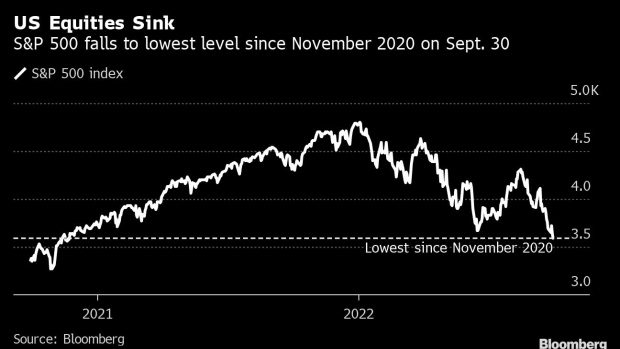Oct 1, 2022
Fed Officials Begin to Split on the Need for Speed to Peak Rates
, Bloomberg News

(Bloomberg) -- Sign up for the New Economy Daily newsletter, follow us @economics and subscribe to our podcast.
Federal Reserve officials are starting to stake out different views on how fast to raise interest rates as they balance hot inflation against rising stress in financial markets.
With Fed target range now at 3% to 3.25% and only a few moves from reaching their forecast peak, officials are starting to speak differently about the urgency with which they need to get there.
Hawks like Cleveland Fed chief Loretta Mester say they must keep raising rates aggressively to win the battle against inflation even if that causes a recession. Vice Chair Lael Brainard has offered a slightly softer assessment while continuing to stress the need to tighten policy.
Brainard’s speech Friday -- the first from Fed board leadership since officials met last week -- said policy will need be restrictive for some time and avoid the risk of prematurely pulling back.
But she injected a note of caution about how fast they need to go, while discussing a number of ways in which the global rate-hiking cycle could spill over on the US economy.
Her San Francisco colleague Mary Daly also highlighted the cost of doing too much -- as well as too little -- to cool prices.
Their comments injected a slight variation into what has been a uniformed stream of insistence from regional Fed presidents declaring unflinching resolve to crush inflation.
The potential costs to the economy of are already being telegraphed in the form of falling asset prices. The S&P 500 declined 9.3% in September in the steepest monthly decline since March 2020 as Covid-19 spread.
Bank of America Corp. says credit stress is at a “borderline critical level” beyond which dysfunction begins. That’s something the Fed wants to avoid because market breakdowns are difficult to control and can accelerate downturns.
The divisions among officials showed up in their forecasts released Sept. 21 that showed 8 officials estimating they would finish the year with rates in a 4% to 4.25% range while nine were a quarter point higher.
One of the dividing lines, said Derek Tang, an economist at LH Meyer in Washington, is differing views on longer-run inflation expectations, with those taking more comfort in the stability of those gauges now saying the committee can take a step-by-step approach in getting to peak rates. Policymakers see that at 4.6% next year, according to their median estimate.
Brainard cautioned that it will take time for the full extent of tightening to bite down broadly across the economy, another way of arguing for some patience starting now.
“Uncertainty is currently high, and there are a range of estimates around the appropriate destination of the target range for the cycle,” she told a conference hosted at the New York Fed on financial stability. “Proceeding deliberately and in a data-dependent manner will enable us to learn how economic activity and inflation are adjusting to the cumulative tightening.”
That contrasts sharply with Fed hawks. In fact, Mester has argued aggressively against down-shifting into more deliberative policy, as officials have done in past tightening cycles when high uncertainty lead the central bank to inch rates up a quarter-point at a time.
At a time when inflation is too high, and the direction of inflation expectations is hard forecast, overshooting is better than undershooting, Mester says.
“Some results in the literature suggest that when policymakers confront more uncertainty either in their data or in their models, they should be more cautious in acting, that is, be more inertial in their responses,” she said in a Sept. 26 speech. “Subsequent research has shown that this is not generally true.”
“It can be better for policymakers to act more aggressively because aggressive and pre-emptive action can prevent the worst-case outcomes from actually coming about,” she added.
The debate about how quickly to get to peak rates is not a discussion about reversing course: Not a single official is talking about easing rapidly once they get there. Labor markets are strong with forecasters estimating another 250,000 jobs added in September, while the latest inflation report was discouraging.
Commerce Department data Friday showed the central bank’s preferred gauge rose 6.2% in the 12 months through August, down from 6.4% in July, but defying forecasters’ expectations for a greater moderation to 6%.
What ultimately determines the pace might be just whether markets remain orderly or not.
“They have made the decision they are going to tighten more rather than less, which certainly suggests the risks are that they will over-tighten. How are we going to see it? You are going to see it in financial conditions and market functioning,” said Julia Coronado, founding parter at MacroPolicy Perspectives.
“I think they still underweight” the risk of chaotic market breakdowns, she added. “When you say we are hellbent on being the fastest car on the road, that encourages a lot of positioning that is one way.”
(Adds Coronado comment in final paragraph)
©2022 Bloomberg L.P.






